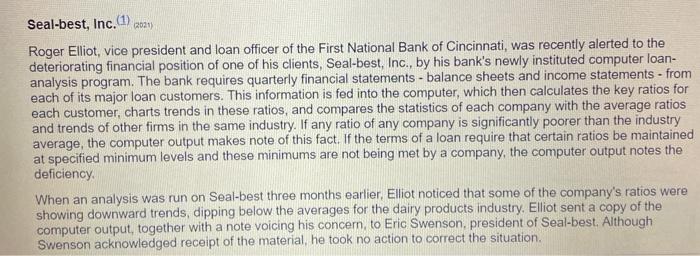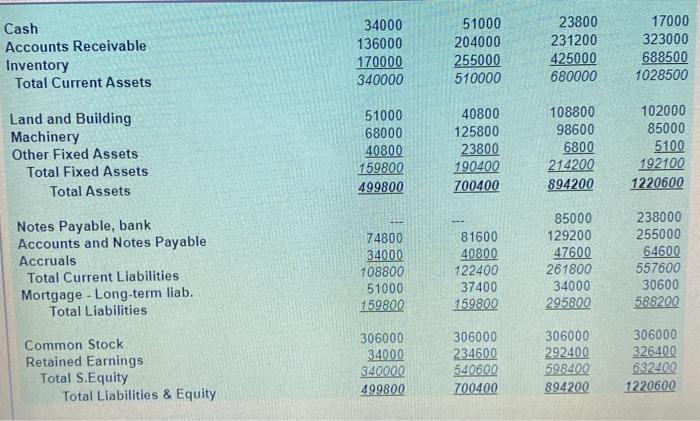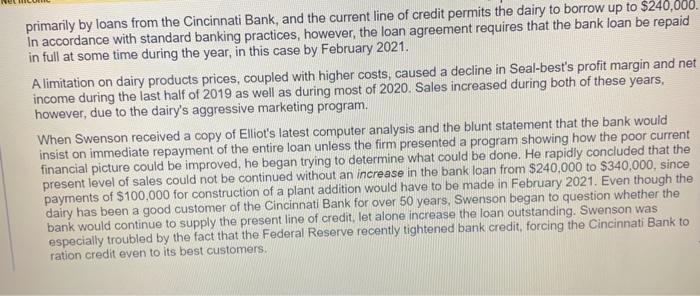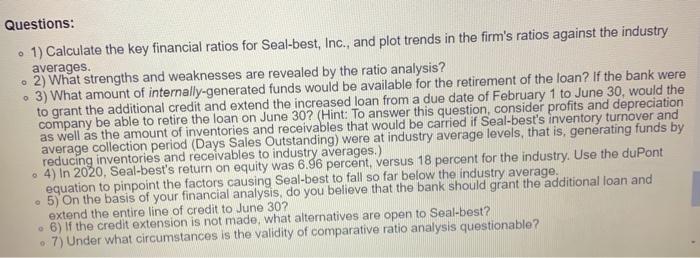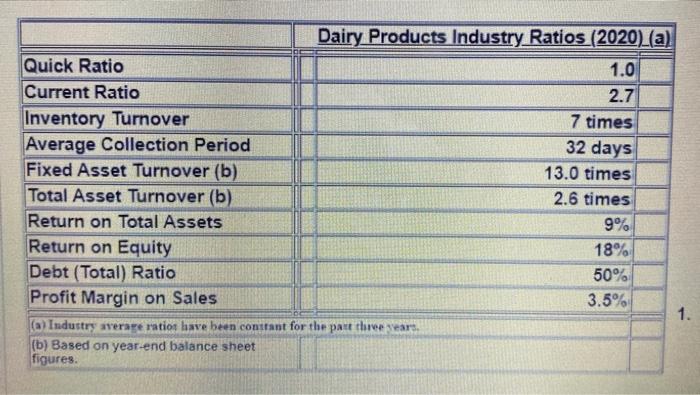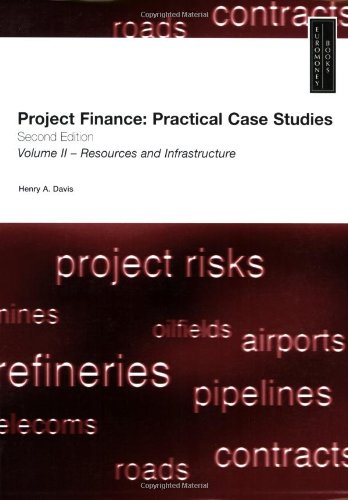Seal-best, Inc. (1) 2021 Roger Elliot, vice president and loan officer of the First National Bank of Cincinnati, was recently alerted to the deteriorating financial position of one of his clients, Seal-best, Inc., by his bank's newly instituted computer loan- analysis program. The bank requires quarterly financial statements - balance sheets and income statements - from each of its major loan customers. This information is fed into the computer, which then calculates the key ratios for each customer, charts trends in these ratios, and compares the statistics of each company with the average ratios and trends of other firms in the same industry. If any ratio of any company is significantly poorer than the industry average, the computer output makes note of this fact. If the terms of a loan require that certain ratios be maintained at specified minimum levels and these minimums are not being met by a company, the computer output notes the deficiency When an analysis was run on Seal-best three months earlier, Elliot noticed that some of the company's ratios were showing downward trends, dipping below the averages for the dairy products industry. Elliot sent a copy of the computer output, together with a note voicing his concern to Eric Swenson, president of Seal-best. Although Swenson acknowledged receipt of the material, he took no action to correct the situation, FIGURE 1 SEAL-BEST, INC. BALANCE SHEET YEAR ENDED DECEMBER 31 The first financial analysis indicated that some problems were developing, but no ratio was below the level specified in the loan agreement between the bank and Seal-best. However, the second analysis, which was based on the data given in Figures 1.2 and 3. showed that the current ratio was below the 2.0 times specified in the loan agreement. According to the loan agreement, the Cincinnati Bank could legally call upon the dairy for immediate payment of the entire bank loan, and if payment was not forthcoming within 10 days, the bank could force Seal-best into bankruptcy. Elliot had no intention of actually enforcing the contract to the full extent that he legally could, but he did intend to use the loan agreement provision to prompt Seal-best to take some decisive action to improve its financial picture Cash Accounts Receivable Inventory Total Current Assets 34000 136000 170000 340000 51000 204000 255000 510000 23800 231200 425000 680000 17000 323000 688500 1028500 Land and Building Machinery Other Fixed Assets Total Fixed Assets Total Assets 51000 68000 40800 159800 499800 40800 125800 23800 190400 700400 108800 98600 6800 214200 894200 102000 85000 5100 192100 1220600 Notes Payable, bank Accounts and Notes Payable Accruals Total Current Liabilities Mortgage - Long-term liab. Total Liabilities 74800 34000 108800 51000 159800 81600 40800 122400 37400 159800 85000 129200 47600 261800 34000 295800 238000 255000 64600 557600 30600 588200 Common Stock Retained Earnings Total S.Equity Total Liabilities & Equity 306000 34000 340000 499800 306000 234600 540600 700400 306000 292400 598400 894200 306000 326400 632400 1220600 ncome Statement 2018 2019 2020 SEAL-BEST, INC. INCOME STATEMENT 469000 68000 Net Sales 2220000 2305000 2390000 Cost of Goods Sold 1768000 1836000 1904000 Gross Operating Profit 452000 486000 Seal-best is a company that handles General Administrative, Selling 170000 187000 a full line of dairy products in central 204000 Depreciation 85000 102000 and southern Ohio. It produces both Miscellaneous 34000 71400 102099 fresh dairy products and such EBT 180000 125600 78000 storable products as powdered milk Taxes (50%) 85000 34000 57800 Net Income s 95.000 S 67.800 14200 and cheese. Seasonal working capital needs have been financed primarily by loans from the Cincinnati Bank, and the current line of credit permits the dairy to borrow up to $240,000. In accordance with standard banking practices, however, the loan agreement requires that the bank loan be repaid in full at some time during the year in this case by February 2021. A limitation on dairy products prices, coupled with higher costs, caused a decline in Seal-best's profit margin and net income during the last half of 2019 as well as during most of 2020. Sales increased during both of these years. however, due to the dairy's aggressive marketing program. primarily by loans from the Cincinnati Bank, and the current line of credit permits the dairy to borrow up to $240,000. In accordance with standard banking practices, however, the loan agreement requires that the bank loan be repaid in full at some time during the year, in this case by February 2021. A limitation on dairy products prices, coupled with higher costs, caused a decline in Seal-best's profit margin and net income during the last half of 2019 as well as during most of 2020. Sales increased during both of these years, however, due to the dairy's aggressive marketing program. When Swenson received a copy of Elliot's latest computer analysis and the blunt statement that the bank would insist on immediate repayment of the entire loan unless the firm presented a program showing how the poor current financial picture could be improved, he began trying to determine what could be done. He rapidly concluded that the present level of sales could not be continued without an increase in the bank loan from $240.000 to $340,000, since payments of $100,000 for construction of a plant addition would have to be made in February 2021. Even though the dairy has been a good customer of the Cincinnati Bank for over 50 years, Swenson began to question whether the bank would continue to supply the present line of credit. let alone increase the loan outstanding. Swenson was especially troubled by the fact that the Federal Reserve recently tightened bank credit, forcing the Cincinnati Bank to ration credit even to its best customers. Questions: 1) Calculate the key financial ratios for Seal-best, Inc., and plot trends in the firm's ratios against the industry averages. 2) What strengths and weaknesses are revealed by the ratio analysis? . 3) What amount of internally-generated funds would be available for the retirement of the loan? If the bank were to grant the additional credit and extend the increased loan from a due date of February 1 to June 30, would the company be able to retire the loan on June 30? (Hint: To answer this question, consider profits and depreciation as well as the amount of inventories and receivables that would be carried if Seal-best's inventory turnover and average collection period (Days Sales Outstanding) were at industry average levels, that is, generating funds by reducing inventories and receivables to industry averages.) . 4) In 2020. Seal-best's return on equity was 6.96 percent, versus 18 percent for the industry. Use the duPont equation to pinpoint the factors causing Seal-best to fall so far below the industry average, 5) On the basis of your financial analysis, do you believe that the bank should grant the additional loan and extend the entire line of credit to June 302 . 6) If the credit extension is not made, what alternatives are open to Seal-best? 7) Under what circumstances is the validity of comparative ratio analysis questionable? Dairy Products Industry Ratios (2020) (a) Quick Ratio 1.0 Current Ratio 2.7 Inventory Turnover 7 times Average Collection Period 32 days Fixed Asset Turnover (b) 13.0 times Total Asset Turnover (b) 2.6 times Return on Total Assets 9% Return on Equity 18% Debt (Total) Ratio 50% Profit Margin on Sales 3.5% (a) Industry average ration have been constant for the past the ears, (b) Based on year-end balance sheet figures. 1. Seal-best, Inc. (1) 2021 Roger Elliot, vice president and loan officer of the First National Bank of Cincinnati, was recently alerted to the deteriorating financial position of one of his clients, Seal-best, Inc., by his bank's newly instituted computer loan- analysis program. The bank requires quarterly financial statements - balance sheets and income statements - from each of its major loan customers. This information is fed into the computer, which then calculates the key ratios for each customer, charts trends in these ratios, and compares the statistics of each company with the average ratios and trends of other firms in the same industry. If any ratio of any company is significantly poorer than the industry average, the computer output makes note of this fact. If the terms of a loan require that certain ratios be maintained at specified minimum levels and these minimums are not being met by a company, the computer output notes the deficiency When an analysis was run on Seal-best three months earlier, Elliot noticed that some of the company's ratios were showing downward trends, dipping below the averages for the dairy products industry. Elliot sent a copy of the computer output, together with a note voicing his concern to Eric Swenson, president of Seal-best. Although Swenson acknowledged receipt of the material, he took no action to correct the situation, FIGURE 1 SEAL-BEST, INC. BALANCE SHEET YEAR ENDED DECEMBER 31 The first financial analysis indicated that some problems were developing, but no ratio was below the level specified in the loan agreement between the bank and Seal-best. However, the second analysis, which was based on the data given in Figures 1.2 and 3. showed that the current ratio was below the 2.0 times specified in the loan agreement. According to the loan agreement, the Cincinnati Bank could legally call upon the dairy for immediate payment of the entire bank loan, and if payment was not forthcoming within 10 days, the bank could force Seal-best into bankruptcy. Elliot had no intention of actually enforcing the contract to the full extent that he legally could, but he did intend to use the loan agreement provision to prompt Seal-best to take some decisive action to improve its financial picture Cash Accounts Receivable Inventory Total Current Assets 34000 136000 170000 340000 51000 204000 255000 510000 23800 231200 425000 680000 17000 323000 688500 1028500 Land and Building Machinery Other Fixed Assets Total Fixed Assets Total Assets 51000 68000 40800 159800 499800 40800 125800 23800 190400 700400 108800 98600 6800 214200 894200 102000 85000 5100 192100 1220600 Notes Payable, bank Accounts and Notes Payable Accruals Total Current Liabilities Mortgage - Long-term liab. Total Liabilities 74800 34000 108800 51000 159800 81600 40800 122400 37400 159800 85000 129200 47600 261800 34000 295800 238000 255000 64600 557600 30600 588200 Common Stock Retained Earnings Total S.Equity Total Liabilities & Equity 306000 34000 340000 499800 306000 234600 540600 700400 306000 292400 598400 894200 306000 326400 632400 1220600 ncome Statement 2018 2019 2020 SEAL-BEST, INC. INCOME STATEMENT 469000 68000 Net Sales 2220000 2305000 2390000 Cost of Goods Sold 1768000 1836000 1904000 Gross Operating Profit 452000 486000 Seal-best is a company that handles General Administrative, Selling 170000 187000 a full line of dairy products in central 204000 Depreciation 85000 102000 and southern Ohio. It produces both Miscellaneous 34000 71400 102099 fresh dairy products and such EBT 180000 125600 78000 storable products as powdered milk Taxes (50%) 85000 34000 57800 Net Income s 95.000 S 67.800 14200 and cheese. Seasonal working capital needs have been financed primarily by loans from the Cincinnati Bank, and the current line of credit permits the dairy to borrow up to $240,000. In accordance with standard banking practices, however, the loan agreement requires that the bank loan be repaid in full at some time during the year in this case by February 2021. A limitation on dairy products prices, coupled with higher costs, caused a decline in Seal-best's profit margin and net income during the last half of 2019 as well as during most of 2020. Sales increased during both of these years. however, due to the dairy's aggressive marketing program. primarily by loans from the Cincinnati Bank, and the current line of credit permits the dairy to borrow up to $240,000. In accordance with standard banking practices, however, the loan agreement requires that the bank loan be repaid in full at some time during the year, in this case by February 2021. A limitation on dairy products prices, coupled with higher costs, caused a decline in Seal-best's profit margin and net income during the last half of 2019 as well as during most of 2020. Sales increased during both of these years, however, due to the dairy's aggressive marketing program. When Swenson received a copy of Elliot's latest computer analysis and the blunt statement that the bank would insist on immediate repayment of the entire loan unless the firm presented a program showing how the poor current financial picture could be improved, he began trying to determine what could be done. He rapidly concluded that the present level of sales could not be continued without an increase in the bank loan from $240.000 to $340,000, since payments of $100,000 for construction of a plant addition would have to be made in February 2021. Even though the dairy has been a good customer of the Cincinnati Bank for over 50 years, Swenson began to question whether the bank would continue to supply the present line of credit. let alone increase the loan outstanding. Swenson was especially troubled by the fact that the Federal Reserve recently tightened bank credit, forcing the Cincinnati Bank to ration credit even to its best customers. Questions: 1) Calculate the key financial ratios for Seal-best, Inc., and plot trends in the firm's ratios against the industry averages. 2) What strengths and weaknesses are revealed by the ratio analysis? . 3) What amount of internally-generated funds would be available for the retirement of the loan? If the bank were to grant the additional credit and extend the increased loan from a due date of February 1 to June 30, would the company be able to retire the loan on June 30? (Hint: To answer this question, consider profits and depreciation as well as the amount of inventories and receivables that would be carried if Seal-best's inventory turnover and average collection period (Days Sales Outstanding) were at industry average levels, that is, generating funds by reducing inventories and receivables to industry averages.) . 4) In 2020. Seal-best's return on equity was 6.96 percent, versus 18 percent for the industry. Use the duPont equation to pinpoint the factors causing Seal-best to fall so far below the industry average, 5) On the basis of your financial analysis, do you believe that the bank should grant the additional loan and extend the entire line of credit to June 302 . 6) If the credit extension is not made, what alternatives are open to Seal-best? 7) Under what circumstances is the validity of comparative ratio analysis questionable? Dairy Products Industry Ratios (2020) (a) Quick Ratio 1.0 Current Ratio 2.7 Inventory Turnover 7 times Average Collection Period 32 days Fixed Asset Turnover (b) 13.0 times Total Asset Turnover (b) 2.6 times Return on Total Assets 9% Return on Equity 18% Debt (Total) Ratio 50% Profit Margin on Sales 3.5% (a) Industry average ration have been constant for the past the ears, (b) Based on year-end balance sheet figures. 1
